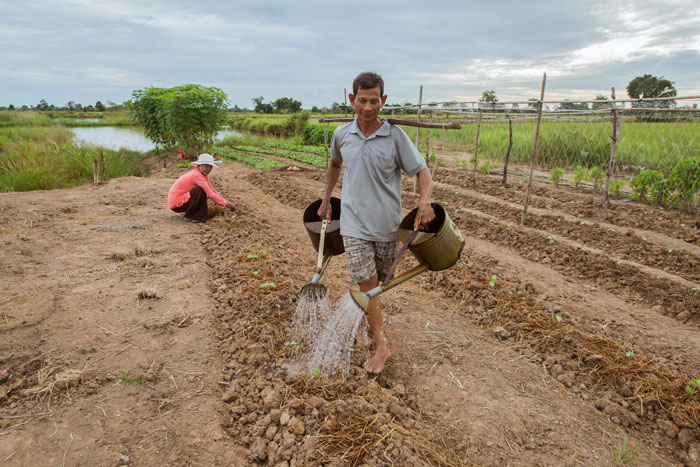
Improving environmental and human well-being through protected areas and payments for environmental services in Cambodia

Context
Out of concerns about environmental sustainability, the global community has adopted a series of international agreements and targets, and invested several billion dollars in biodiversity conservation. Despite this, there is relatively little evidence about whether conservation interventions work, why they work and under what circumstances.
Protected areas and payments for environmental services are widely adopted policies designed to provide benefits to local people conditional upon achieving an environmental outcome or change in behavior. The hypothesis that protected areas and payments for environmental services improve human well-being and changes behavior to enhance environmental outcomes has rarely been tested with empirical data.
Since 2002, the Wildlife Conservation Society has been supporting the government and local community partners to develop sustainable conservation models in the three protected areas: Kulen Promtep (established 1993), Chhaeeb (established 2002) and Prey Preah Rokha (established 2016) wildlife sanctuaries. The landscape is managed by the Provincial Department of Environment with oversight from the General Department of Administration of Conservation and Protection within the Cambodian Ministry of Environment.
The Wildlife Conservation Society implemented three payments for environmental services interventions aimed at complementing protected area management. These consisted of a direct payments scheme conditional upon protection of nests of globally threatened birds; a community-managed ecotourism intervention that provides conditional support if villagers engage in bird and habitat protection; and Ibis Rice that provides farmers with premium prices for rice if households comply with pro-environmental commitments. The aim of this evaluation was to quantify the impact of protected areas and payments for environmental services on environmental and human well-being in the Northern Plains landscape of Cambodia. It built on a nine-year monitoring program initiated in 2008 and followed a quasi-experimental design in which a socioeconomic household survey was conducted with the same panel of households every three years (2008, 2011, 2014 and 2017) in control and treatment villages.
Evidence
This study found that households living inside the protected areas were not worse off relative to households in similar villages outside the PAs for any of the indicators considered. Households living inside the protected areas have improved their economic status at a greater rate than matched control households for the 2008-2017 period. No impact of protected areas was found for total rice harvest or household food security. Participation in the Ibis Rice intervention was found to be positively associated with increased economic status, increased rice harvest and improved food security for the 2014-2017 period. No impact was found for participation in the bird’s nest protection intervention, while participation in the ecotourism intervention was found to have a positive association with household food security for the 2014-2017 period.
An analysis of the deforestation rates between 2000-2018 found that deforestation was significantly lower for points surrounding villages within the protected areas than for matched points in control villages. A further analysis of points surrounding villages within the protected areas to measure the effect of the Ibis Rice program found little evidence of reduced annual deforestation of villages that participated, except for two villages.
Evidence impacts
Type of impact: Improve the culture of evidence use
When decision makers or implementers demonstrate positive attitudinal changes towards evidence use or towards information the research team provides. Examples include strengthening monitoring and evaluation systems, increasing understanding of evidence and openness to using it, integrating these systems more firmly into programming or commissioning another evaluation or review.
This is one of 3ie’s seven types of evidence use. Impact types are based on what we find in the monitoring data for an evaluation or review. Due to the nature of evidence-informed decision-making and action, 3ie looks for verifiable contributions that our evidence makes, not attribution.
Read our complete evidence impact typology and verification approach here.
Close windowEvaluation findings led the Ibis Rice Conservation Company Limited to focus its growth strategy on recruitments within existing villages rather than just extending to new territories. Although the Ibis Rice program was found to reduce clearance among participating farmers, minimal effects were observed for the total deforestation rates surrounding participating villages. The researchers take the results to suggest that there is a critical mass of proportional participation needed within villages for the Ibis Rice program to impact the deforestation rates and recommended that the program should focus on increasing participation within existing villages. Given this, Ibis Rice Conservation Company now closely monitors farmer uptake of the payments for environmental services program within a village as a key performance indicator.
Type of impact: Inform the design of other programs
Where findings from the evaluation or review inform the design of a program(s) other than the one(s) evaluated.
This is one of 3ie’s seven types of evidence use. Impact types are based on what we find in the monitoring data for an evaluation or review. Due to the nature of evidence-informed decision-making and action, 3ie looks for verifiable contributions that our evidence makes, not attribution.
Read our complete evidence impact typology and verification approach here.
Close windowThe evaluation findings informed the Wildlife Conservation Society Cambodia’s decision to continue to expand in the Northern Plains and to develop a similar scheme in the Keo Seima Wildlife Sanctuary in Eastern Cambodia. The Ibis Rice program will be modified to suit the local situation while retaining aspects that led to its success in the Northern Plains.
Suggested citation
3ie, 2021. Improving environmental and human well-being through protected areas and payments for environmental services in Cambodia (online summary), Evidence Impact Summaries. New Delhi: International Initiative for Impact Evaluation (3ie).
Evidence impact summaries aim to demonstrate and encourage the use of evidence to inform programming and policymaking. These reflect the information available to 3ie at the time of posting. Since several factors influence policymaking, the summaries highlight contributions of evidence rather than endorsing a policy or decision or claiming that it can be attributed solely to evidence. If you have any suggestions or updates to improve this summary, please write to influence@3ieimpact.org